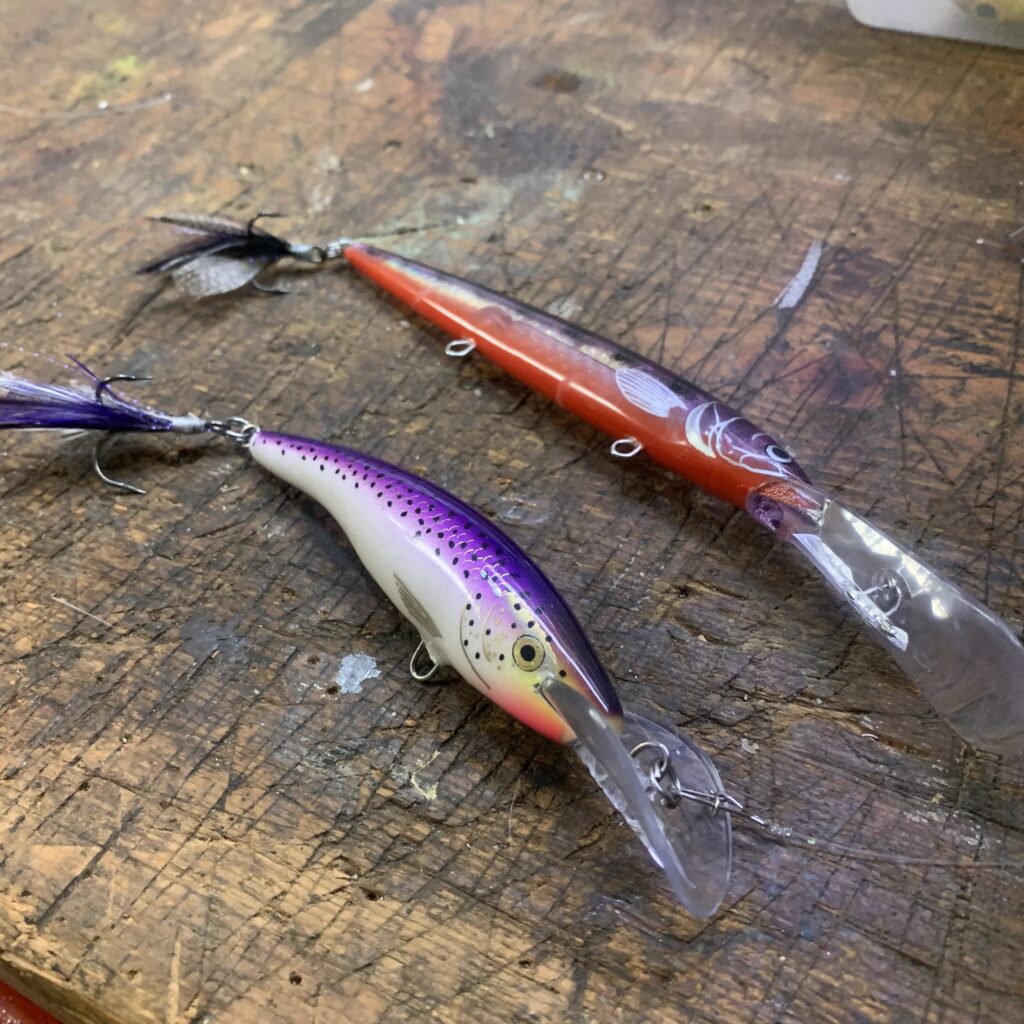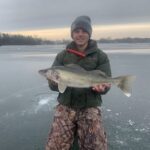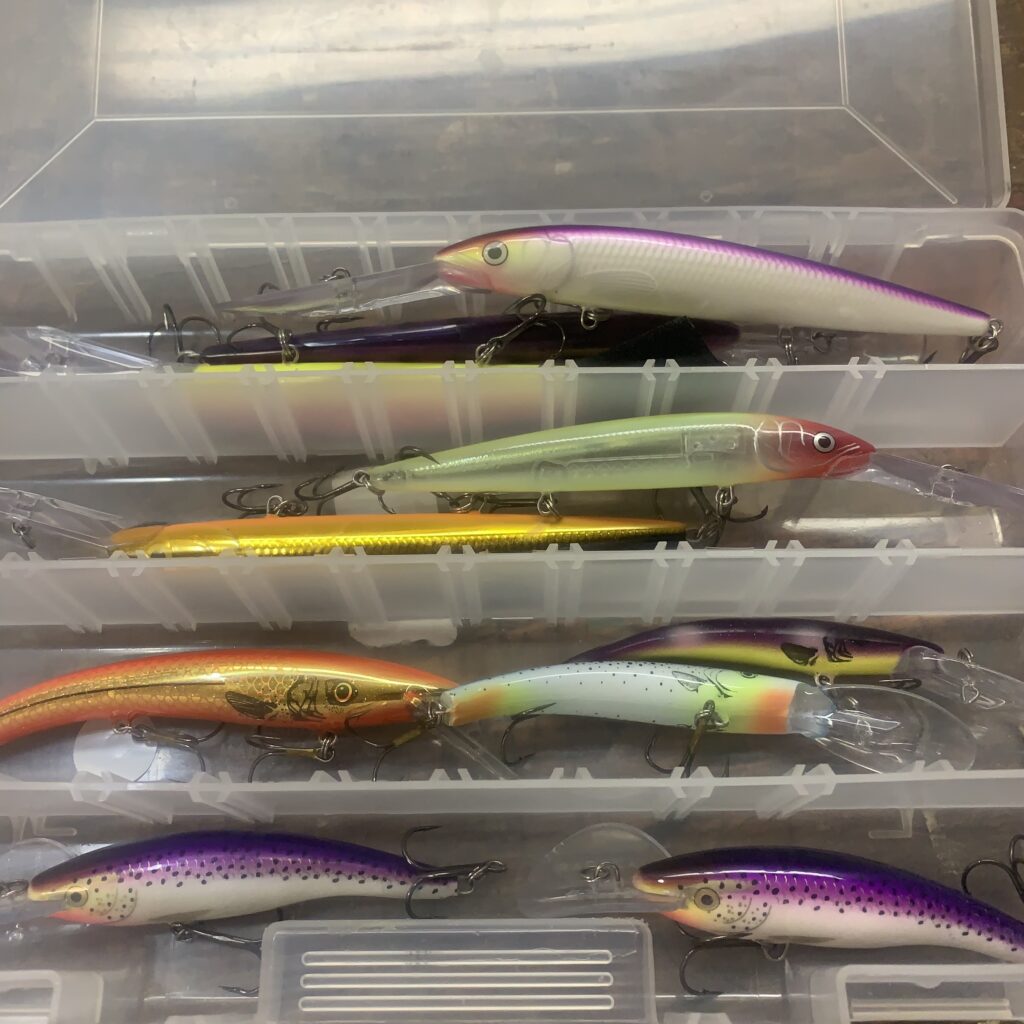Hey there anglers! Crankbaits are one of the most versatile and widely used lures when it comes to walleye fishing. Crankbaits work across the country and can be fished throughout most of the year. With that being said, crankbaits come in a variety of different styles and can get confusing. If you are looking to up your walleye fishing game, you’re in the right place. Whether you’re an experienced angler or just starting out, this guide will provide you with everything you need to know about how to fish crankbaits for walleye.
As always, fishing education and conservation are our priorities here at The Angler’s Line. Feel free to sign up for our free newsletter to join our community and stay up to date! Lets get started!
Table of Contents:
Choosing the Right Crankbait
First things first, let’s talk about how to choose the right crankbait for walleye fishing.
Choosing The Shape
Walleye crankbaits comes in two main shapes; I call them shade profiles and minnow profiles. The shad profiled crankbaits are shorter in length and taller in height. Minnow profiles are much longer and more slender. Think of a bluegill shape vs. a perch. Choose between either of these crankbait profiles depending on the walleye forage in your lake. Match the hatch!
Diving Depth
Diving depth is one of the most critical considerations to make when choosing a crankbait for walleye fishing. Crankbaits dive to different depths based on their bill length and angle. In most scenarios, you’ll want a crankbait to run within a few feet of the bottom. One exception to this is if you plan on fishing walleye in the weeds. In this case, run your crankbait a few feet over the tops of the weeds to prevent constant snags.
The line that you use plays a key role in the diving depth of your crankbait as well, especially when trolling. The thicker the line, the shallower your bait will dive. I recommend using an app like precision trolling to really hone your presentation in and know exactly how deep your baits are running.
Rattles
Crankbaits typically come in silent versions or versions with rattles. Rattles are meant to get fishes attention. I tend to favor rattles when fishing murkier water or large expansive areas where I need to bring fish in from long distances. Silent crankbaits are my preferred choice when fishing walleye in clear water and for highly pressured fish.
Color
A lot of walleye anglers get caught up on color. It can make a difference, but there are other factors that play a much larger role in your success. For the most part, opt for natural colors and match the hatch in clear water. In dirty water, choose bright and bold colors that stand out. This holds true for night fishing walleye as well.
Modifications (remove from treble)
As most anglers know, crankbaits are rough on fish. If you have any intentions of practicing catch and release fishing, I highly recommend making a few modifications. Experiment with removing the leading treble hook or hooks on your crankbait, and only leave the last one. Walleye only end up biting one hook and the other ones end up snagging gills and injuring the fish. Additionally, this will help decrease the time it takes to unhook the fish as well. Tie a feathered treble to the remaining hook, and walleye will hone in and strike this specific hook anyways.

I know a lot of people are going to disagree and say that your hooking percentage is going to go way down by doing this. All I can say is that it hasn’t for me, so try it out for yourself.
Seasonal Considerations
Crankbaits work for walleye fishing throughout all open water seasons, but the way that you fish them changes.
Spring
In the spring, shallow diving crankbaits work well in the shallows. Walleyes move up shallow to spawn this time of year, and crankbaits provide a great way to cover water and target these fish. Either cast shallow crankbaits or troll them. Focus on fishing during low-light conditions for the best chance of success this time of year.
Summer
In the summer, crankbaits work great due to their aggressive action. Warmer water temperatures mean that walleyes are more willing to chase down faster moving baits. Two two main places to fish crankbaits for summer walleye is either shallow weed edges or deep hard bottom areas. When fishing shallow weed edges, casting crankbaits or flat line trolling is generally the way to go. This way you’ll know when your bait is running clean and when it has weeds on it. For mid-lake hard bottom areas, trolling is the best method to cover water and spread out lines to target these fish.
Fall
In the fall, walleye feed aggressively on bait fish. When fall walleye fishing, look for schools of fish grouped up in the shallows near drop-offs to the main basin. These steep breaks are few areas in the fall since they allow walleye to corral baitfish and feed. Crankbaits due a great job of imitating these baitfish. Keep in mind that the bait tends to be larger in size this time of year. Using larger than normal crankbaits can be the key to success this time of year and can land you a trophy in the process.
Crankbait Gear and Equipment
In order to effectively fish crankbaits for walleye, you’ll benefit from having the right gear.
Casting Rod and Reel
A spinning rod or baitcasting rod will both work when it comes to casting crankbaits. Choose whichever types of rod you prefer. A longer rod is beneficial for this technique for two reasons. Firstly, it increases casting distance and allows you to get your lure further from the boat in shallow water. Additionally, longer rods tend have a softer tip and load deeper into the rod blank which is crucial when fishing treble hooked baits. I prefer rods between 7’ and 7’6” in length, that are medium light power.
Trolling Rod and Reel
Unlike most other walleye fishing applications, trolling is a technique where a baitcasting rod and reel is preferred. For length, I recommend choosing a trolling rod between 7-8 ft. As you get more advanced, you may want to think about getting several lengths of rods and putting longer rods toward the boat bow and shorter rods toward the boat stern. This will help to disperse your lures properly and helps to prevent tangles between lines. For rod power, I recommend a medium power for walleye fishing.
As far as reels go, choose either a low-profile or round style baitcasting reel depending on your preferences. Some reels have a line counter included, which is a nice added bonus when trolling for walleyes but by no means necessary. This allows you to precisely adjust the length of line that you let out and experiment with different depths to find what works on a given day.
Line
I want to emphasize that line is critical for crankbaits. Make sure to use either fluorocarbon or monofilament, not braided line. Fluorocarbon and monofilament have stretch, which keeps treble hooks pinned. Braided line does not have any give and tends to rip trebles out of fish’s mouth. Choose a line anywhere between 10-20 lb test depending on the size of fish you are targeting. Remember, the thinner the line the deeper you’ll be able to reach with you crankbait.
How To Fish Crankbaits For Walleye
What you’ve all been waiting for, the different techniques to use for crankbait fishing
Casting and Retrieving
Casting is my go to technique when walleye are grouped up in shallow water. Casting allows you to target these fish without spooking them. Additionally, you’ll be faced with weeds and other cover a lot of the times in shallow water. Casting enables you to feel the lure’s vibration to ensure it is running cleanly at all times. When casting crankbaits, long casts are everything. The further you can get your lure from the boat, the longer it will be in the strike zone and the less chance you have of spooking fish.

Trolling
Trolling is probably the most popular way to fish crankbaits for walleye. This technique allows you to run multiple lines and spread your lures out. I tend to troll when fishing large main-lake structure that are relatively uniform in depth. When done correctly, you know that your baits are in the strike zone at all times. You can either troll with planer boards or straight behind the boat. 2mph is a good rule of thumb for crankbaits. If you can’t reach the desired depth by flat line trolling, consider adding snap weights. This is where an app like Precision Trolling really comes into play to help you know exactly what depth your lures are running at. Having the right trolling gear is very important.
Tips To Land and Handle Walleye With Crankbaits
Crankbaits can induce a lot of damage and stress to fish, so make sure you land and handle fish carefully.
Reel Slowly
No need for any big hooksets and rod pumps. Just reel in the fish and maintain constant pressure. It is easy for fish to shake crankbaits when you try to horse them into the boat.
Have a Net and Pliers Ready
The last thing you want to do is try and unhook a feisty walleye with treble hooks flying around. This is a recipe for disaster. Be prepared with a net and pliers to make the unhooking process go much smoother.
Catch and Release
Adhere to catch-and-release guidelines whenever possible to preserve the walleye population for future generations. Handle fish with care, use barbless hooks to minimize injury, and return them to the water as quickly and gently as possible. If you plan on keeping a few fish for a meal, release the larger fish to let them spawn. When trolling, walleye may experience barotrauma as well. Avoid fishing in depths greater than 30 ft, and learn how to fizz walleye.
There you have it – everything you need to know about how to fish crankbaits for walleye. First and foremost, set yourself up with the right gear and crankbait for the job. Learn the seasonal migration of walleye and hone in on the key areas depending on the time of year you are fishing. Finally, do what you can to minimize harm to the fish with crankbaits for catch and release success. So put your newfound knowledge to the test the next time you’re out on the water. Tight Lines!
More Walleye Articles:
- Ice Fishing For Walleye: Everything You Need To Know

- Midday Walleye: A Complete Breakdown Of Daytime Walleye Fishing

- Live Bait For Walleye: Everything You Need To Know

- Lure Talk: Full Guide On Fishing Crankbaits For Walleye

- Lure Talk: How To Fish Spinner Rigs For Walleye

- Trolling For Walleye: Everything You Need To Know

